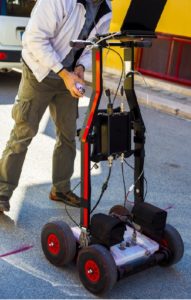
Using ground penetrating radar, you can find all of your utilities and do all of your mapping without tearing up lawns.
People want to have lovely lawns. It’s of high value to homeowners to keep their lawns looking nice. However, it’s also essential to have accurate imaging and mapping of various utilities. Grass is of high importance because it gives kids a place to play, offers oxygen, lowers the amount of noise and air pollution we have, helps to control soil erosion, and protects groundwater. Grass also helps give our lawns the aesthetic appeal we want from them. The thought of having to dig up your lawn and destroy all of that beautiful grass is not appealing. But there is a solution that lets you find utilities while keeping your grass safe. Using ground penetrating radar, you can find all of your utilities and do all of your mapping without tearing up lawns.
What Is Ground Penetrating Radar?
Ground-penetrating radar (GPR) is a geophysical locating method. It takes images of areas just below the surface by sending out pulses of energy. Using GPR, the ground is never disturbed, making it a non-destructive method of finding all underground utilities. Ground-penetrating radar has two main pieces of equipment that it uses: a transmitter and a receiving antenna. What the transmitter does is send electromagnetic energy into the substrate. If the impulse comes into contact with an obstacle, that object will refract, reflect, and scatter the signal. The receiver identifies any returning signals and records any variations they have. GPR software then takes these signals and turns them into images of the objects that were found underground.
Ground-penetrating radar harbors many traits of seismology. The big difference is that seismology uses the acoustic energy of seismic waves while GPR uses electromagnetic waves. GPR uses high-frequency radio waves that can detect alterations in any electrical properties taking place underground. It is capable of working on many different surfaces, including soil, ice, freshwater, rock, pavement, and structures as well. That means you can use ground penetrating radar in many different environments. Concrete scanning GPR can find different structural elements found in concrete slabs that can be as thick as 20 inches.
Concrete Visions Will Get The Job Done Right
Concrete Visions has been working with clients for over 25 years. Our G&M Services installers are certified with the industry’s major firestop product manufacturers. As part of our firestop service, we can assess abnormal field conditions and, with the manufacturer’s technical support assistance, provide engineering judgments in a timely fashion to comply with contract specifications. Our Field Mechanics undergo ongoing training, including mandatory monthly safety meetings, weekly Toolbox Talks where safety and equipment information is shred, and trainings on safe work standards and safety best practices.
Visit our website to see how we can be of service to you, and follow us on Facebook, Twitter, and Linkedin.
